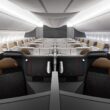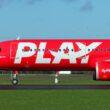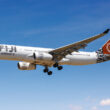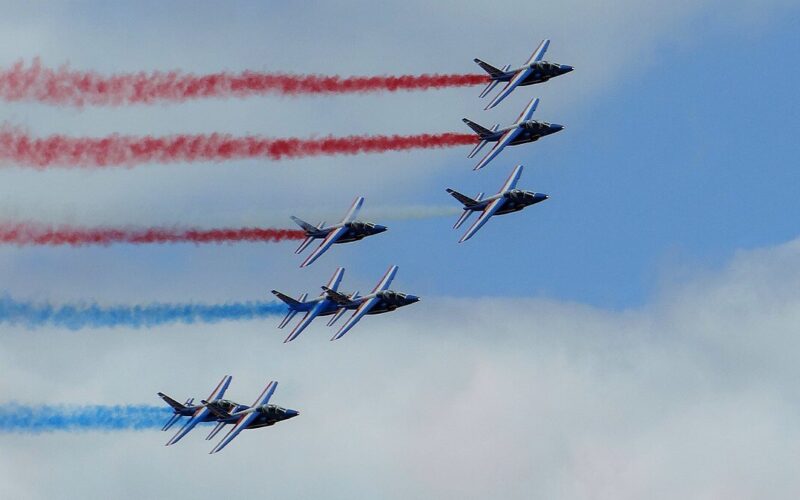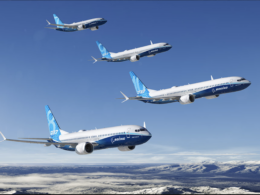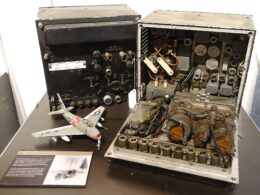Winners and Losers of the Paris Air Show 2019 – Orders and other deals
As the weekend flew past by, the Paris Air Show did so as well. One of the biggest aviation events of the year has been a success for some, a failure to others.
There were blockbuster announcements and announcements that shocked both the aviation community and the general public.
As the show closed on Friday, we look back at one of the most important aviation events and reflect the winners and unfortunately, the losers of the 53rd Paris Air Show.
Winners of the Paris Air Show 2019
Let’s begin with the aircraft manufacturers and airliners that captured the headlines of media all around the world.
1. Airbus A321XLR
Announced on Monday, the Airbus A321XLR captured the heads and minds of airlines in every region of our lovely planet.
In total, airlines have ordered around 200 XLR’s. According to Airbus, the new aircraft won 48 firm orders, 79 commitments and 99 conversions from the regular A321 to the Airbus A321XLR version.
Additionally, JetBlue (JBLU) added a last minute order of 13 Airbus A321XLR, which were converted from their previous order of the A321neo.
Nevertheless, the Airbus A321XLR has raised some questions regarding the passenger experience. We explore this further right here.
2. Boeing 737 MAX
While the A321XLR showed up big time at Paris, Boeing and IAG’s deal came out of the blue.
Both companies have announced a letter of intent for a potential order of 200 Boeing 737 MAX aircraft, which has caused some turbulence in the media.
All in all, the announcement was both a testing ground and a breakthrough.
Firstly, IAG avoided the MAX branding in its press release. Nevertheless, the media did use the MAX designation when talking about the order. In a way, it could have been a deal to test out the public‘s reaction to the order. Speculation has followed whether IAG has received a huge discount or the potential order will be converted to the 777X or the new Boeing NMA/797. As a result, IAG would not even actually receive any of Boeing’s 737 aircraft.
Secondly, the deal is massive for Boeing’s public image – the fact that airlines are beginning to show trust in the manufacturer after a very dry spell of orders is great news for the company. The Boeing 737 MAX is still grounded pending approval by the FAA and rest of the aviation authorities, but getting business done is very important for the future success of the aircraft type.

3. ATR
Obviously, the main topic of the Paris Air Show was the commercial battle between Airbus and Boeing. But Boeing is battling its own crisis after the Boeing 737 crashes and Airbus is still going on its sales push for the A220, A321XLR and other aircraft.
However, the regional turboprop aircraft market is a battleground that’s no less important than the fight between the two major competitors. Though the demand for turboprops isn’t as huge as for narrow-bodies, aircraft manufacturers like ATR have indicated that turboprops are the only way for 36% of airports in the world to connect with other airports.
Nevertheless, ATR has been struggling.
One of the reasons is that there is a big gap in the supply of aircraft and pilots. According to Reuters, ATR struck a deal with IndiGo to not only deliver their most popular ATR 72 model, but the European manufacturer will also supply pilots.
Nevertheless, the Paris Air Show is regarded as a successful one for ATR. The turboprop manufacturer, partially owned by Airbus, launched their newest project, the ATR 42-600S. The STOL (short take-off and landing) turboprop will allow regional airlines to use shorter (800 meters) runways for their operations.
In addition, ATR secured a whole heap of orders. Most importantly, the 75 new orders were firm orders. Out of the 75 new reservations, 17 are for the ATR 42-600S STOL.
4. Embraer
On the other side of the engine spectrum in the regional aircraft market, Embraer has had a very blissful Paris Air Show.
The Brazilian manufacturer celebrated their 50th anniversary with two big orders.
First of all, on the first day of the show, Embraer announced a big deal with United Airlines to serve their regional branch, United Express. The U.S. based airline has committed to 20 E175 aircraft, with an option to purchase 19 more.
While Embraer is pretty much the dominant force in the 70-seat market in the United States, you’d see a different story when traveling to different parts of the world.
Nevertheless, Embraer also announced one more big deal at Paris. KLM’s regional airline branch, KLM Cityhopper has placed 15 firm orders for the E195-E2 with 20 more optional purchases.
Embraer has stated that deliveries will begin in the second half of 2020 for United Express, while the schedule for the deliveries to KLM is set to be announced soon.
Losers of the Paris Air Show 2019
While some have aircraft types have enjoyed the sunshine of Paris, some sat at the back of the stage with little-to-none attention towards them.
These are the losers of Salon du Bourget:
1. Airbus A330-800
In 2014, Airbus launched the A330neo – the re-engined version of their most successful wide-body jet. The European manufacturer announced two versions of the neo, namely the A330-800 and the A330-900.
The main difference between the -800 and the -900 is that the -800 seats fewer passengers, but has 1.700 kilometers more range.
One more difference is that nobody wants the -800. While up until May the -900 has attracted the attention of many airlines with 230 total orders, the Airbus A330-800 only has… 10.
And the 53rd Paris Air Show did not increase that number. Airbus received exactly 0 orders for the A330-800, raising questions whether the type is needed at all.
If you‘re wondering why the A330-800 is so unpopular, simply put the reason that it seats fewer people, thus airlines make much less money per flight compared to the bigger brother of the -800. And the range advantage is not enough to persuade airlines into purchasing the A330-800.

2. Airbus A350
Airbus used their own 50th anniversary to sell massive amounts of single-aisle jets, namely the A220 and the A321XLR. These two were Airbus‘ stars at the Paris Air Show.
But as we just mentioned previously that the A330-800 received absolutely no interest, airlines also avoided the Airbus A350, as Airbus gathered 0 orders for their flagship aircraft.
While the A350 has gathered a lot of attention throughout the years with 893 orders in total, the Paris Air Show was supposed to be Airbus‘ fight for the superiority of the A350 versus the 787 and the 777X.
Unfortunately for both manufacturers, none of them secured a significant number of orders during the show.
3. Boeing
There is no secret that the 53rd Paris Air Show is very different for Boeing. Amidst an unprecedented crisis in the aviation industry, the American giant went on a wild rollercoaster ride in Paris.
Unfortunately, their only high was the fact that IAG has signed an LOI for 200 Boeing 737 MAX aircraft, as we mentioned above.
Rest of the show was one big ride downwards with a small glimmer of hope at the end.
Throughout the festivities, Boeing only managed to secure:
10 firm orders;
47 Letters of Intent (not including the 200 LOI for the 737 MAX);
And 25 options to purchase their jets.
Both the firm orders and the 25 options are for Boeing‘s newest converted freighter, the Boeing 737-800BCF. Meaning Boeing sold 0 passenger airliners.
But at the same time, this is the current reality of the Chicago-based manufacturer, as the whole aviation industry has lost their trust in Boeing.
This Paris Air Show was different for Boeing. Although they did not get many firm orders, their main goal was to start rebuilding the trust between the company and customers – airlines and passengers alike.
So, in a way, the aviation community did not expect much from Boeing. Yet at the same time, the hype for their flagships, especially the 777X was at an all-time high.
However, a delay two weeks before the Paris Air Show to the first test flight of the Boeing 777X due to issues with the GE9X engines did not help at all.
4. Mitsubishi
Mitsubishi has been making steady moves to further increase their chances of breaking through with their regional jet SpaceJet, formerly known as the MRJ.
Just last month they’ve opened up new offices in the United States and as I mentioned, they’ve also rebranded their regional aircraft from the MRJ to the SpaceJet.
The Paris Air Show was supposed to be huge for the company. Mitsubishi plans the SpaceJet to enter commercial service in 2020 with All Nippon Airways. The Japanese airline ordered the SpaceJet in 2008.
Nevertheless, a year before the first commercial flights are about to kick off, Mitsubishi has already axed one of the variants of the SpaceJet and instead has introduced the M100.
The new variant will be compliant with the scope clause that is used in the United States, limiting the size of regional aircraft that airlines can operate. Airlines and pilot unions have established the agreement in 2009.
Nevertheless, the market that Mitsubishi sees as the biggest user of Regional jets did not show much interest in the M100. One unidentified airline from the United States has signed a Memorandum of Understanding for 15 SpaceJet M100 aircraft.
Also, this quote from Mitsubishi’s presentation is questionable, to say the least:
When people ask us what makes us think we can deliver #SpaceJet, we look back on our journey to get here and our culture and we know we can do it. #pas19 #paxex pic.twitter.com/ybLplUFyH8
— Seth Miller (@WandrMe) June 17, 2019
The same corporate culture has delayed the SpaceJet’s entry into service from 2013 to 2020, still not installing any confidence in Mitsubishi’s ability to deliver on their promises.
Narrow-bodied aircraft dominated Paris
To sum up the 53rd Paris Air Show, it’s obvious that narrow-body aircraft completely stole the show.
The Airbus A220, Airbus A321XLR and the Boeing 737 MAX were the dominant forces in Paris. While they won the show, wide-body jets were shunned.
According to FlightGlobal, airlines have signed agreements for 866 aircraft in total. 64% of those deals were for single-aisle jets, while wide-body aircraft made up 7% of the total ordered airliners.
However, aircraft manufacturers have expected lower order numbers for their wide-body products. As a result of huge backlog numbers, both Airbus and Boeing can deliver new aircraft only a few years down the line.
For example, Airbus recently delivered an Airbus A350 to Japan Airlines, which was the first of many wide-bodies that the Japanese airline has ordered.
And the date that Japan Airlines finalized a deal with Airbus was October 7th, 2013.
So, the waiting list for new aircraft is quite long, especially wide-body airliners.

